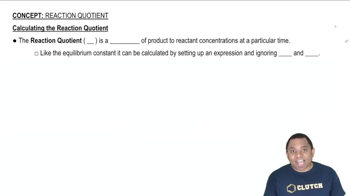At 1000 K, 𝐾𝑝 = 1.85 for the reaction SO2(𝑔) + 12 O2(𝑔) ⇌ SO3(𝑔) (c) What is the value of 𝐾𝑐 for the reaction in part (b)?
Ch.15 - Chemical Equilibrium

Brown14th EditionChemistry: The Central ScienceISBN: 9780134414232Not the one you use?Change textbook
Chapter 15, Problem 26a
Consider the following equilibrium, for which 𝐾𝑝 = 0.0752 at 480°C: 2 Cl2(𝑔) + 2 H2O(𝑔) ⇌ 4 HCl(𝑔) + O2(𝑔) (a) What is the value of 𝐾𝑝 for the reaction 4 HCl(𝑔) + O2(𝑔) ⇌ 2 Cl2(𝑔) + 2 H2O(𝑔)?
 Verified step by step guidance
Verified step by step guidance1
Identify that the given reaction is the reverse of the original reaction.
Recall that the equilibrium constant for the reverse reaction is the reciprocal of the equilibrium constant for the forward reaction.
Write the expression for the equilibrium constant of the reverse reaction: \( K'_{p} = \frac{1}{K_{p}} \).
Substitute the given value of \( K_{p} = 0.0752 \) into the expression for the reverse reaction.
Calculate the reciprocal to find \( K'_{p} \), which is the equilibrium constant for the reverse reaction.

Verified video answer for a similar problem:
This video solution was recommended by our tutors as helpful for the problem above.
Video duration:
1mWas this helpful?
Key Concepts
Here are the essential concepts you must grasp in order to answer the question correctly.
Equilibrium Constant (Kp)
The equilibrium constant, Kp, is a numerical value that expresses the ratio of the concentrations of products to reactants at equilibrium for a given reaction at a specific temperature. It is calculated using the partial pressures of gases involved in the reaction. A Kp value less than 1 indicates that at equilibrium, reactants are favored, while a value greater than 1 indicates that products are favored.
Recommended video:
Guided course

Equilibrium Constant Expressions
Le Chatelier's Principle
Le Chatelier's Principle states that if a dynamic equilibrium is disturbed by changing the conditions, the system will adjust itself to counteract the change and restore a new equilibrium. This principle helps predict how changes in concentration, pressure, or temperature will affect the position of equilibrium in a chemical reaction.
Recommended video:
Guided course

Le Chatelier's Principle
Reaction Quotient (Q)
The reaction quotient, Q, is a measure of the relative amounts of products and reactants present in a reaction at any point in time, not just at equilibrium. It is calculated in the same way as Kp but uses the current concentrations or partial pressures. Comparing Q to Kp allows us to determine the direction in which the reaction will proceed to reach equilibrium.
Recommended video:
Guided course

Reaction Quotient Q
Related Practice
Textbook Question
Textbook Question
Consider the following equilibrium, for which Kp = 0.0752 at 480°C: 2 Cl2(g) + 2 H2O(g) ⇌ 4 HCl(g) + O2(g) (b) What is the value of Kp for the reaction Cl2(g) + H2O(g) ⇌ 2 HCl(g) + 1/2 O2(g)?
Textbook Question
The following equilibria were attained at 823 K:
CoO(s) + H2(g) → Co(s) + H2O(g) Kc = 67
CoO(s) + CO(g) → Co(s) + CO2(g) Kc = 490
Based on these equilibria, calculate the equilibrium constant for H2(g) + CO2(g) → CO(g) + H2O(g) at 823 K.
Textbook Question
Consider the equilibrium N2(𝑔) + O2(𝑔) + Br2(𝑔) ⇌ 2 NOBr(𝑔) Calculate the equilibrium constant 𝐾𝑝 for this reaction, given the following information at 298 K:
2 NO(𝑔) + Br2(𝑔) ⇌ 2 NOBr(𝑔) 𝐾𝑐 = 2.02
NO(𝑔) ⇌ N2(𝑔) + O2(𝑔) 𝐾𝑐 = 2.1×1030
